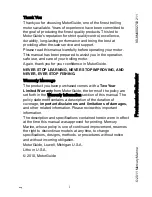PowerPC e500 Core Family Reference Manual, Rev. 1
Freescale Semiconductor
C-1
Appendix C
Simplified Mnemonics for PowerPC
Instructions
This chapter describes simplified mnemonics, which are provided for easier coding of assembly
language programs. Simplified mnemonics are defined for the most frequently used forms of
branch conditional, compare, trap, rotate and shift, and certain other instructions defined by the
PowerPC™ architecture and by implementations of and extensions to the PowerPC architecture.
Most of this information is also provided in the appendixes of reference manuals and the
Programming Environments Manual for 32-Bit Implementations of the PowerPC Architecture
(referred to as the Programming Environment Manual). However,
Section C.11, “Comprehensive
List of Simplified Mnemonics
,” provides an alphabetical listing of simplified mnemonics that are
used by a variety of processors. Some assemblers may define additional simplified mnemonics not
included here. The simplified mnemonics listed here should be supported by all compilers.
C.1
Overview
Simplified (or extended) mnemonics allow an assembly-language programmer to program using
more intuitive mnemonics and symbols than the instructions and syntax defined by the instruction
set architecture. For example, to code the conditional call “branch to an absolute target if CR4
specifies a greater than condition, setting the LR without simplified mnemonics, the programmer
would write the branch conditional instruction, bc 12,17,target. The simplified mnemonic, branch
if greater than, bgt cr4,target, incorporates the conditions. Not only is it easier to remember the
symbols than the numbers when programming, it is also easier to interpret simplified mnemonics
when reading existing code.
Although the original PowerPC architecture documents include a set of simplified mnemonics,
these are not a formal part of the architecture, but rather a recommendation for assemblers that
support the instruction set.
Many simplified mnemonics have been added to those originally included in the architecture
documentation. Some assemblers created their own, and others have been added to support
extensions to the instruction set (for example, AltiVec instructions and Book E auxiliary
processing units (APUs)). Simplified mnemonics have been added for new architecturally defined
and new implementation-specific special-purpose registers (SPRs). These simplified mnemonics
are described only in a very general way.
Содержание PowerPC e500 Core
Страница 1: ...PowerPC e500 Core Family Reference Manual Supports e500v1 e500v2 E500CORERM Rev 1 4 2005...
Страница 36: ...PowerPC e500 Core Family Reference Manual Rev 1 xxxvi Freescale Semiconductor...
Страница 38: ...PowerPC e500 Core Family Reference Manual Rev 1 Part I 2 Freescale Semiconductor...
Страница 316: ...PowerPC e500 Core Family Reference Manual Rev 1 7 18 Freescale Semiconductor Performance Monitor...
Страница 332: ...PowerPC e500 Core Family Reference Manual Rev 1 Part II 2 Freescale Semiconductor...
Страница 362: ...PowerPC e500 Core Family Reference Manual Rev 1 10 26 Freescale Semiconductor Auxiliary Processing Units APUs...
Страница 440: ...PowerPC e500 Core Family Reference Manual Rev 1 A 8 Freescale Semiconductor Programming Examples...
Страница 444: ...PowerPC e500 Core Family Reference Manual Rev 1 B 4 Freescale Semiconductor Guidelines for 32 Bit Book E...
Страница 530: ...Opcode Listings PowerPC e500 Core Family Reference Manual Rev 1 D 50 Freescale Semiconductor...
Страница 534: ...PowerPC e500 Core Family Reference Manual Rev 1 E 4 Freescale Semiconductor Revision History...


















